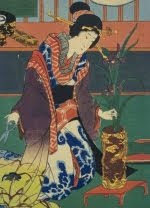Narcissus, leaves and flowers.
Nicely arranged flowers is a great way to make guests feel appreciated. One of the most efficient ways to use Ikebana in modern environments is to place a welcoming flower arrangement in the entrance hall to greet the guests on their way in. In Japan these arrangements are often placed low on the floor, "looking up" at the guest.
Traditionally ikebana is used in typically Japanese environments, such as the tokonoma alcove in a room with tatami floor, or to accompany a tea ceremony in a special tea room. Living with flowers in a Western environment means reinterpreting these traditions and finding new situations for ikebana.
More and more the bathroom has become a room for wellbeing and revitalization. This is where the guest can get a moment of rest from engaging conversations and social obligations. A simple ikebana arrangement helps you feel refreshed and in balance. In my experience a small not too overwhelming arrangement is the most refreshing.
Traditionally ikebana is used in typically Japanese environments, such as the tokonoma alcove in a room with tatami floor, or to accompany a tea ceremony in a special tea room. Living with flowers in a Western environment means reinterpreting these traditions and finding new situations for ikebana.
More and more the bathroom has become a room for wellbeing and revitalization. This is where the guest can get a moment of rest from engaging conversations and social obligations. A simple ikebana arrangement helps you feel refreshed and in balance. In my experience a small not too overwhelming arrangement is the most refreshing.
This ikebana arrangement with Narcissus takes no more than a couple of leaves and two stems of flowers. I don't know the name of this specific variety, but it has a wonderful scent that makes it even more suitable. I arranged the flowers in a raku teacup by my friend Brigitte Schneider of Atelier Tokibana. After taking the photos I curled the tips of the leaves in a soft upward curve. This made the arrangement more harmonious and added a welcoming energy.
What's your favorite place for an ikebana?
What's your favorite place for an ikebana?














